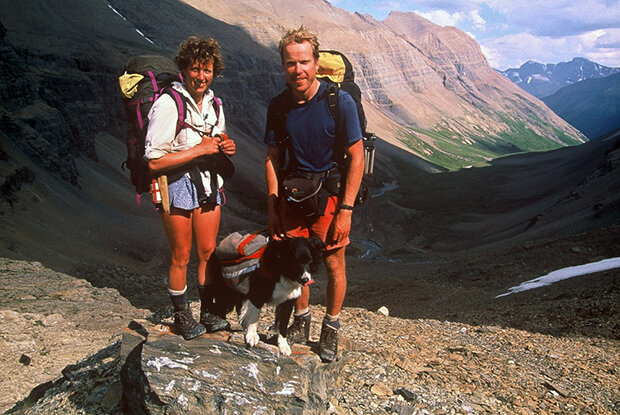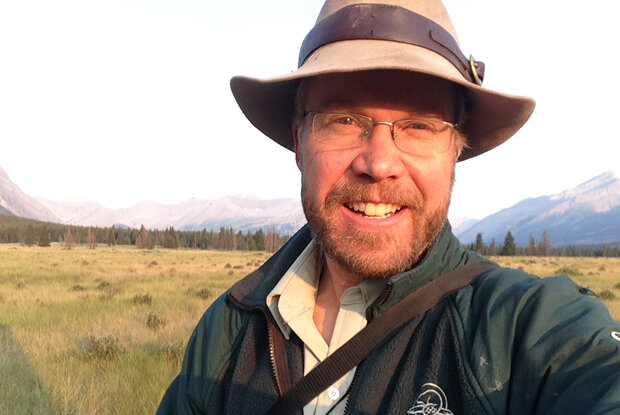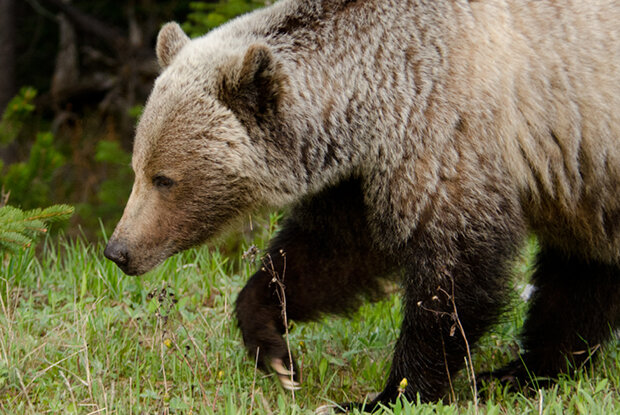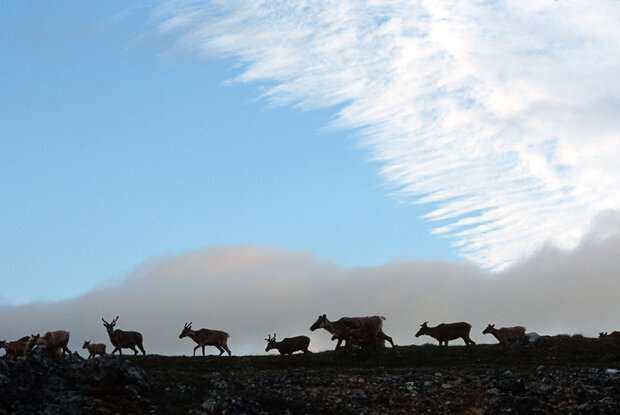KARSTEN HEUER: A LIFE SHAPED BY THE Y2Y VISION
By Lynn Martel
Karsten Heuer is known for many things, in particular big journeys across the Canadian landscape. In this in-depth interview with the conservationist, biologist and author, Lynn Martel uncovers what has inspired his journeys, and where they’ve brought him today.
The idea was simple: Karsten Heuer, a wildlife biologist, wondered how much wilderness was left intact amidst a landscape disrupted by roads, seismic lines and other human development along the Yellowstone to Yukon (Y2Y) corridor. For answers, in 1998 he decided to travel the spine of the Rockies – 3,400 kilometres – on foot, skis and by canoe. He was stalked by bears, barely survived crossing raging rivers, and received death threats from misinformed locals he met along the way.
His landmark journey ended in Watson Lake, Yukon, after travelling 188 days in three separate sections over the course of 18 months. For Heuer – who shared the adventure in his spellbinding book, Walking the Big Wild, and recently wrapped up a term serving as President of the Y2Y Conservation Initiative – hiking Y2Y turned out to be just the beginning.
LM/ What early memories of nature do you cherish?
KH/ My folks immigrated to Canada from Germany just before I was born. Growing up in Calgary, we spent every weekend in Banff or Kananaskis cross-country skiing, hiking or fishing. My dad was a fanatical fisherman – get up at 3 a.m. and hike four kilometres in the dark to a backcountry lake to be there at dawn. Those early mornings – birds singing, mist rising off the lake, the vanilla scent of pines hanging in the air – really stick in my mind. Whenever I see, hear or smell those things now I feel like I’ve returned home.
LM/ What did you study?
KH/ I studied ecology at the University of Calgary. It was a second choice after veterinary medicine- that’s because I was allergic to everything with fur and four feet. I got on with Parks Canada as a student working for a wildlife biologist and pretty much never returned to the city after that.
LM/ How did you first learn about Y2Y?
KH/ Harvey Locke, a Calgary-based environmental lawyer, who co-founded Y2Y, gave a presentation at the Banff Library. It was the mid-1990s and a lot of things were coming together to suggest national parks and other reserves weren’t big enough if we really wanted to save nature. Radio collars were new technology showing us animals like wolves and grizzly bears frequently crossed provincial, state and international borders. Genetic analyses were discerning that the grizzly bears in Yellowstone were becoming inbred because they were trapped on an island. Satellite imagery was beginning to reveal how our protected areas were becoming completely surrounded by roads, clearcuts, seismic lines and other human development. Meanwhile, I was working on a wildlife tracking study around Banff and one of our study animals, a radio-collared wolf, had just gone from Banff to northern Montana to Idaho to BC.
Everything Harvey was talking about – the need to think big and to conserve wildlife corridors from Yellowstone to the Yukon – made perfect sense.
LM/ What inspired your Y2Y journey?
KH/ Y2Y was such a great idea that I needed to tell others, and do it in as compelling a way as possible. I decided to try and be one of those grizzly bears, wolves or wolverines making the journey; to walk, step-by-step, from Y to Y and see what barriers did and didn’t exist along the way.
LM/ How did you decide on the parameters?
KH/ I wanted to travel a line that a grizzly or wolverine might take, which meant taking the wildest route possible. It turned out to be 3,400 kilometres long, took a year and a half of walking, skiing and paddling, and meant getting food caches into some pretty remote places by bush plane, especially in northern BC.
LM/ How much did you know about long-distance wilderness travel?
KH: Not much! I had to seek advice from seasoned long-distance wilderness travellers. Don Gardner didn’t only tell me how to hang food caches to keep them from the jaws of hungry wolverines, but he came on a multi-day ski trip to place one of those caches. We’ve been great friends ever since.
LM/ What were the journey’s highlights?
KH: There were a lot: seeing bears and wolverines in some of the wildest places in the world, getting to the other side after swimming some pretty big rivers, and meeting some incredibly dedicated conservationists who know and love the places where they live. Perhaps that was the most rewarding aspect of the trip – stopping in communities to give presentations and media interviews along the way, and each time getting a deep education about all the things that made that place special. I remember always heading back to the trailhead to continue walking with a much deeper appreciation for where I was heading and where I’d been.
LM/ What were your biggest challenges?
KH/ We’d hired a publicist to go ahead and set up presentations and media interviews. We were making a pretty big splash by the end of the first year, so much so that some of the resource industry types – Fording Coal and the Forestry Alliance of BC – started mounting an anti-Y2Y campaign full of misinformation. Some of the crowds that showed up for our small town presentations were pretty angry and combative. We had death threats. I had to learn how to communicate effectively in some pretty stressful situations.
LM/ What were your greatest blessings?
KH/ I came to realize that one of my long-time friends, Leanne Allison, who joined me for some of the toughest sections of the journey including the entire second half, would make a pretty good wife. We got married soon after the trip was over and have been soul and trip mates ever since.
LM/ Did you think you’d be an author before your Y2Y journey?
KH/ No. McClelland & Stewart saw an article about the trip in the Globe and Mail just as I was leaving. He called and asked me if I’d ever thought about writing a book. I said no, I was too busy just planning the thing and now I was going to be pretty consumed doing it. He said I should think about it, take good notes about what happened, and call him when I was done. A year and a half later, I did.
LM/ How did Y2Y inspire Being Caribou?
KH/ By the time we’d finished the Y2Y Hike we knew we had a pretty good model for telling a conservation story to a lot of people: we’d done more than 200 presentations, news stories had run in hundreds of North American magazines, papers and on local, regional and national radio and TV. We decided to do it again, only this time we wouldn’t just symbolically walk where the animals might travel – we’d try and follow 120,000 caribou on foot and in real time.
LM/ How did you come to be Y2Y President?
KH/ I was ready for a different kind of challenge and to take what I had learned in town halls and on the trail into the political halls and corporate boardrooms of the Rocky Mountain West. And I loved it.
LM/ What did you feel you could contribute?
KH: I was, and continue to be, passionate about the Y2Y vision and wanted to contribute that passion and energy to specific outcomes on the ground, whether it be building more wildlife overpasses across highways, securing more private land from subdivision and development, and getting more parks and wildlife corridors designated on public lands. I wanted to use my authentic voice and experiences in the region to inspire and motivate others to contribute to the vision for a connected and protected system of wild lands and wild waters in one of the most hopeful landscapes on Earth.
LM/ What did you learn?
KH/ Pacing. If anything, I came out of the start gate a little too hot and keen. I wanted to do too much too quickly and when things didn’t go as quickly as I’d hoped I took it personally. It was a demanding job and I burned out pretty fast. It was a big lesson in setting realistic goals for myself and letting go of things I can’t control.
LM/ How did being Y2Y President fit in your life story?
KH/ It felt pretty natural, especially at the beginning. Although it didn’t work out for the long-term I have no regrets. I met and worked with a lot of great and committed people. I learned a lot about political strategy. I got to flex all those communication muscles I grew in those small town community halls during the Y2Y Hike but with more of a platform behind me. And I got to see for myself that this grand vision we’ve all been working on for two decades really is possible. Since I first heard Harvey Locke utter the words “Yellowstone to Yukon” in Banff in 1994, the amount of protected land in the region has nearly doubled, and other conservation designations (some of which function as wildlife corridors) have increased by 30 times.
LM/ Do you see Y2Y playing a role in your future?
KH/ Absolutely. I continue to work for the Y2Y Conservation Initiative formally as a part-time contractor and strategic advisor, and informally as an ambassador. I’ll be a lifelong ambassador. This stretch of mountains where I grew up and still live is in my blood and breath and I’ll die trying to conserve as much of it as I can. Not for my sake but for the wild beauty of self-willed life.
LM/ What’s next?
KH/ I’ve returned to my roots as a wildlife biologist. I’m working a day job to reintroduce a free-roaming herd of Plains bison to Banff National Park. I’m also chipping away at some wildlife corridor projects in the Bow Valley (outside the Park) and a couple of personal writing projects. And Leanne and I are openly talking about dusting off the hiking boots and revisiting much of the Y2Y trip 20 years later – this time with our son.
Author of two books of adventure and nine mountain biographies, Lynn Martel explores the Canadian Rockies backcountry by skis, boots, camera and the written word.




